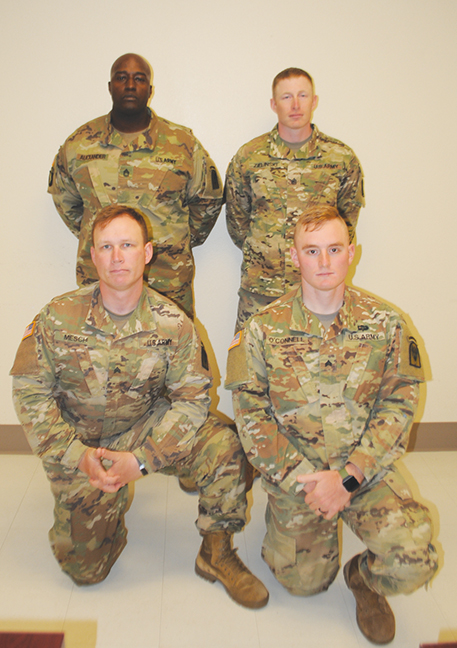By Jean Dubiel
Guardian Staff Writer

A four-man small arms shooting team from 3rd Battalion, 353rd Training Brigade, Joint Readiness Training Center Operation Group, traveled to Fort Benning, Georgia March 8-17.
353rd Tigers Shooting Team Competes at Benning
March 29, 2019
FORT POLK, La. — A four-man small arms shooting team from 3rd Battalion, 353rd Training Brigade, Joint Readiness Training Center Operation Group, traveled to Fort Benning, Georgia March 8-17 to compete in the U.S. Army Marksmanship Unit small arms competition, also called the “All Army” shooting competition as it brings together Soldiers from across the force (Reserve, National Guard and active duty) for one event.
Sgt. 1st Class Daizon Alexander said the team used Sig Sauer M17s and Beretta M9s (both are military service pistols), as well as the M4 and M16 (military assault rifles).
The distances they aimed for at the pistol range were 10 to 35 yards for supported (two-handed) grip, and up to 50 yards for one-handed shooting.
Competitors were required to shoot while standing, kneeling or in the prone position.
For the rifle range, shooters aimed at targets that were 100-500 meters away. During some of the heats, shooters had to sprint between shooting positions, changing form standing to sitting to prone, and at times having to wait until they reached their positions before they could load the weapon.
Alexander said it felt amazing to represent the 353rd at this competition.
“There were a lot of people they could have picked, but they hand selected us for this team,” said Alexander. “It was an honor to represent the unit.”
While the competition tested the best of the best, many competitors used the event as a learning experience.
“It was great to get with other units and learn from their experiences and techniques,” said Alexander. “I can increase my knowledge by adding the things I learned from them.”
Tiger team member Sgt. Johnnie Mesch said his favorite part of the competition was the multi-gun assault course.
“You’d start with the M4 (rifle) with targets on either side of you, and you had to put two rounds in each. Then you had to sling (the rifle), pull out your M9 (pistol) and engage more targets,” said Mesch. “That event was graded for speed and accuracy, so there was a nice little stress factor there.”
Sgt. 1st Class Brian Zielinski said he found the multi-gun event to be the most challenging.
“It’s not very often that you use two different weapons systems back-to-back with the time factor added in,” he said, adding that he preferred the pistol events because he has more experience with handguns over rifles. “There was a steep learning curve on the first event, and I learned a lot about where I stand compared to people who train day in and day out for these kind of competitions. But I had fun and would love to do it again.”
Sgt. Patrick O’Connell said none of the weapons used for the competition are his weapon of choice — he prefers larger calibers.
“I was a SAW (squad automatic weapon) gunner for the longest time and it’s the weapons system I have the most experience with but the M4 works well for me,” he said. “This event gave me a chance to learn more about the M9 (pistol), which is something I haven’t shot very often, but I had plenty of opportunity to do that while we were there.”
O’Connell’s favorite event was the NTIT, or national trophy infantry team match.
“We had to run together from one berm to the next, but had no ammo — it was waiting at the berms. We had to load and shoot from the positions, and the event was for time so we had to work fast,” he said. “The catch was that no speed loaders were allowed, so we had to load it all by hand.”
O’Connell said he learned a great deal at the M9 range, not only by observing others but also through talking with fellow competitors about their experiences with the firearm.
“There are many ways to kneel or lay down to make a shot, and it was good to see all the different techniques,” said O’Connell. “The competition was a great way to network and I think we all learned from each other.”
Alexander advised that anyone considering entering next year’s competition should spend plenty of time getting their shot group tight. “Qualifying twice a year is not going to be enough to win,” he said. “Start practicing now.”




